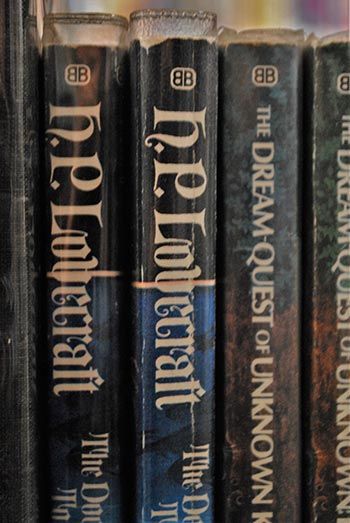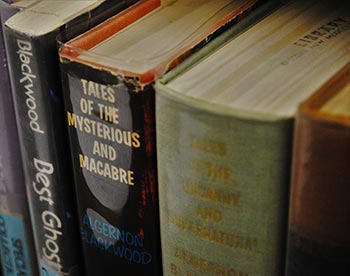In the spirit of writing about books, it's time to move on to short stories!
They're like diet books; books lite; books, alpha build. (Get it? Because computers?)
If you enjoy reading, but you don't enjoy the length or commitment that books require, short stories are bite-sized enough to fulfill your satisfaction.
As a quick tangent that's totally going to connect to my main point and blow your mind in three paragraphs: I just recently discovered that the man, the myth, the legend, Guillermo del Toro himself, is directing a movie for a series of scary stories that would give me nightmares as a kid (but I would read anyway).
That's right: for those who watched the Super Bowl, you probably saw the forty-second TV spot for the film "Scary Stories to Tell in the Dark."
This film looks terrifying, simply because it seems to follow the two minute short stories in a coherent way. As of March 28, there's even a trailer out for it, and I fully expect to revisit my eight-year-old nightmares. The film itself comes out on August 9, 2019.
To whet your appetite for it, and again, to follow up on my books blog, I'd like to share my favorite horror shorts I've read in my life. That's right, folks—these are my very own scary stories to tell in the dark.
This recommendation list is based on my personal opinion, by the way—I'll be talking about the stories that have stayed with me since I've read them.
Also, these books can all be read either online or through the Eastern New Mexico University Golden Student Success Center. The three authors I cover have long since passed away, and their work is so old that it's become public domain. All that means is that no one has a copyright on it anymore, so you can easily find it online as well.
As for the GSSC, I've included their call numbers for you to find yourselves. If you're like me and numbers am not work so good in head, don't hesitate to talk to a librarian or the reference desk next to Einstein Bros.
Fair warning: spoilers exist beyond this point.

"The Cask of Amontillado," by Edgar Allan Poe. It's a story about a murder in the cleverest of ways. I love this story. It's so simple and is quite possibly the shortest story on this list.
In my opinion, this story is so old and short that it's hardly worth describing in detail. You'll gain more from reading the story itself.
It was published in 1847 by the most prolific horror writer of all time, Mr. Nevermore himself, Edgar Allan Poe. If you've read a vast majority of Poe's work, it follows the sincere sophistication that his words tend to carry.
This could be due to the speech of the day it was written in, but reading it by today's standards just creates an impression that the narrator is incredibly well-educated and noble. It's very exciting to read.
I mean, you know how this story ends. Spoilers for a story written over 150 years ago, but the narrator lures his "friend" into the catacombs by promising him a very vintage wine. The narrator then gets his victim drunk and tricks him into a depression in the wall at the end of the catacombs, where he chains the guy to the wall and builds a wall in front of it before covering the wall with bones.
Brutal and clever from a master of fear.
My rating: 5/5 amontillado casks. Not scary per se, but oddly funny and fascinating. Go read it, please! It's an essential Poe story.
Since this one was a tad bit short, bonus points for the following Poe stories:
"The Fall of the House of Usher"
"The Masque of the Red Death"
"The Tell-Tale Heart"
"The Pit and the Pendulum"
"The Bells"
Extra bonus points for watching "Extraordinary Tales" on Netflix, which animates a series of Poe stories in various animation styles and starring the likes of Christopher Lee, Bela Lugosi and Guillermo del Toro.
Christopher Lee, for those who don't recognize the name, played characters such as Saruman the Wise in the "Lord of the Rings" movies, Count Dooku in "Star Wars," Dracula in 1958 and Willy Wonka's dentist dad in the Johnny Depp/Tim Burton film from 2005.
Bela Lugosi, in comparison, was a Romanian actor known for classic black and white horror like "Dracula" and "The Wolf Man" in the early to mid-20th century. This was accomplished through archive recordings, given that he passed away in 1956.
Guillermo del Toro, if you haven't caught on, has directed a number of films including the 2004 "Hellboy" with Ron Perlman, 2013's kaiju blast "Pacific Rim," 2017's really weird communist aquatic/human love story "The Shape of Water" and my personal favorite, "Pan's Labyrinth" in 2006.
Again, he's one of the directors for "Scary Stories to Tell in the Dark."
Basically, "Extraordinary Tales" is a compilation of awesome Poe stories and totally worth watching, especially if you're well versed in his works.
In the GSSC, Edgar Allan Poe stories can be found in the general collections, PS 2600.F27, on the first floor.

Literally anything by H. P. Lovecraft. Perhaps one of the most iconic and influential horror and occult writers of all time, Howard Phillips Lovecraft was born August 20, 1890, and died on March 15, 1937.
H. P. Lovecraft is one of the pioneers of modern day horror. It was through his work that "cosmic horror" was essentially created.
If you don't know any of his work, stop kidding yourself. You do, I promise. Cthulhu was his little monster baby. Yeah, that guy. You know the one.
Lovecraft, although not well known in his time, wrote some very iconic pieces. Although his scale was not limited to that of the cosmos and extraterrestrial deities, that seems to be what he is most remembered for.
Lovecraft created a very extensive grimoire of horrific oddities, referred to as eldritch monsters, in his novellas and poetry alike. Some of these creatures include:
Cthulhu: A great evil being of gigantic size (hundreds of meters tall). It is vaguely humanoid, with the wings of a dragon and its head resembling an octopus. It rests imprisoned in an underwater city in the South Pacific, where one day it will awake and destroy humanity. Can't pronounce the name? Don't worry—kuh-tool-oo is as close to its native alien language that the human vocal cords can reach.
Elder things: Extraterrestrials that colonized Earth one billion years ago. Imagine a flattened but still inflated basketball, with a variety of tentacle appendages around its midsection and on its legs at regular intervals around the body. It's got a pair of strange bat-like wings with a mushroom-looking head, and its five eyeballs attached to it with more tentacles. Or just google them. Their purpose? Space farers. They were just living, man. Just like us.
Nyarlathotep: The evil beyond all evils. His whole deal is that he's the culmination of every single evil god in the mythos to date. Need I say more? He appears a handsome middle-aged man, but that's only one of over a thousand forms that will immediately create insanity in whoever sees him. A lot of gods are like that.
This is the tiniest handful of things you could find in the Cthulhu mythos. What's cool about it is that these stories didn't stop with Lovecraft's death; Lovecraft let other authors take command of his stories and add on to them. These stories have been added on to throughout the course of the 20th century.
What's terrifying about these creatures is that due to their horror, anyone who sees them goes mad in time. They lose their minds entirely, and the eldritch things don't stop there.
Basically, there's not really a "good" god in Cthulhu mythos per se, and they all want to destroy the Earth, humanity, the universe and everything in it or mixtures of all three. Pleasant stuff.
My rating: 5/5 eldritch beasts. Lovecraft is incredibly complex, fascinating lore that will carry with me for the rest of my life. Fair warning: Lovecraft also wrote in a different era. Some stories may once again use outdated vocabulary that is often regarded as racist. Lovecraft himself was, in fact, very racist—and that sucks because his work is unparalleled by anyone else.
Looking to get started, but there are so many stories you don't know where to look? Here are my H. P. Lovecraft picks, varying from stories to poetry:
"At the Mountains of Madness"
"The Call of Cthulhu"
"The Dunwich Horror"
"Dagon"
"Nyarlathotep"
"Through the Gates of the Silver Key"
"Fungi from Yuggoth"
Again, this is a tiny handful of his works. There are so many; it was almost impossible to choose my favorites.
All of them deal with cosmic oddities and obscenities that are sure to haunt your wildest nightmares.
In the GSSC, H. P. Lovecraft can be found in the Jack Williamson collection, PS 3523, on the second floor.

"The Wendigo," by Algernon Blackwood. If it's not immediately obvious, I like wendigoes. I talked briefly about another book about them previously in my books blog. Anything wendigo related, I'm all over it: "Pet Sematary," "Until Dawn," "Supernatural"… literally anything.
This story, however, is special.
Written in 1910 by Algernon Blackwood, a dairy farmer, hotel operator, newspaper reporter, bartender, model, private secretary and violin teacher (and those were just his jobs—he had even more numerous hobbies that mostly dealt with outdoors stuff), this horrific tale is probably where most modern wendigo lore stems from.
For a bit of background on the creatures themselves, wendigoes come from Algonquian folklore. It's a mythical creature that is described as an evil spirit, typically found in the Northern United States (i.e., Great Lakes Region), Eastern Seaboard United States and Canada.
Typically, they are seen as creatures who have possessed humans and turned them into cannibalistic beasts. They can be anywhere from nine to twenty feet tall, and it's said that the more they eat, the hungrier and bigger they become in proportion. Their primary meal is humans in general. Yum, yum.
Example: A wendigo eats a dude whole because it's hungry. Rather than satiating that hunger, it only creates more by making the wendigo grow in the size of the creature it just devoured. Now the wendigo is hungry enough to eat another guy on top of everything else it's hungry for, as well as absorbed the person's size into itself. This is so it can never truly be satiated.
They're terrifying.
They've been associated in more modern times with tall tales to discourage people of greed, murder, gluttony and taboo. This is a description from a Canadian tribesmen of the beast:
"The Wendigo was gaunt to the point of emaciation, its desiccated skin pulled tightly over its bones. With its bones pushing out against its skin, its complexion the ash gray of death, and its eyes pushed back deep into their sockets, the Wendigo looked like a gaunt skeleton recently disinterred from the grave.
What lips it had were tattered and bloody ... Unclean and suffering from suppurations of the flesh, the Wendigo gave off a strange and eerie odor of decay and decomposition, of death and corruption."
When Europeans started colonizing North America, they saw the truths to these tales for themselves. Rather than attribute the madness of men to the doings of an evil supernatural entity, they called what they saw "wendigo psychosis"—named for the creature spoken of by the tribes of the area.
The validity of this medical term is hotly debated today ever since tribes native to the areas mentioned above have come into contact with Euro-based peoples. This brought Euro ideologies as well, and their lives became less rural and more sedentary, effectively reducing the occurrence of wendigo-like instances.
I can't seem to find much about the status of any of this in today's society, and for that I'm sorry. I would tell you about it in 2019 if I could, everyone.
I know I'm probably giving off a bit too much information about this, but it's important to me for everyone reading to understand why I think this story, in particular, is so terrifying.
Since I talked so long about the origins of this thing, I'll try to keep the plot summary brief. Big warning here: this story was written in 1910, which was a very different time in terms of speech and that's because of a normalized regard for racism in the period.
I won't repeat what they say exactly, but to those who decide to read the story, you've been warned that there's some pretty old language in it that is widely regarded in today's society as highly offensive. Most copies of the tale have edited it this to be more socially acceptable while maintaining its original meaning, but it slips through the cracks in some copies.
"The Wendigo" focuses on a five-person moose hunting trip consisting of the Scotsmen Simpson and his uncle, Dr. Cathcart—who is the author of a book on collective hallucination (which doesn't seem important, but can you guess what Cathcart thinks what the wendigo is when he is told about it or when he encounters it?)—as well as their guides, Hank Davis and Joseph Défago. They also bring a native man named Punk as their cook at base camp.
Punk stays at their main camp while Simpson pairs with Défago and Cathcart pairs with Hank. With that, the two groups go their separate ways and start hunting for moose.
After a long day of rowing a canoe, Simpson and Défago make camp twelve miles from their main camp. Their spirits are high, and as the sun sets and their fire blazes, Défago suddenly seems to notice something. He won't tell Simpson what it is, however, and the pair goes to bed.
They share a restless night, in which Simpson notices some strange things going on: Défago cowers close to him in a manner as if something was lurking outside the visibility of their tent; Défago's sleeping mat seems to have been dragged a few inches out of the tent, his feet sticking out of the tent and into the night; and Simpson hears Défago's voice being called out from the woods by a "sort of windy, crying voice… as of something lonely and untamed, wild and of abominable power…."
Dawn comes, and Défago awakes with a fury. He stands just outside of the tent and is swept away at incredible force by something unseen and just like that, he's gone. All Simpson can hear is Défago's unholy cries of pain.
Simpson investigates and finds some strange footprints that inexplicably lead to nowhere, but no sign of Défago. He returns to the base camp somehow and finds the rest of his party, who agree collectively to search for Défago. They find nothing of him.
That night, after Hank vents his frustrations at losing his friend into the night, they hear a voice in the distance:
"Oh, oh! This fiery height! Oh, oh! My feet of fire! My burning feet of fire!"
Simpson recognizes the phrase as what Défago said before he was taken. A shape in the sky zooms above them and lands on the ground a distance away with the crashing and crunching of breaking tree branches.
It's quiet except for the soft crunch of heavy footsteps over snow, approaching the group.
Closer and closer it came. "It was endless—too prolonged to be quite real—this measured and pitiless approach. It was accursed."
Finally, a figure emerges.
"Something like a skin of horror almost perceptibly drew down in that moment over every face, and three pairs of eyes shone through it as though they saw across the frontiers of normal vision into the Unknown. Défago advanced, his tread faltering and uncertain; he made his way straight up to them as a group first, then turned sharply and peered close into the face of Simpson. The sound of a voice issued from his lips--
'Here I am, Boss Simpson. I heered someone calling me.' It was a faint, dried up voice, made wheezy and breathless as by immense exertion. 'I'm havin' a reg'lar hellfire kind of a trip, I am.' And he laughed, thrusting his head forward into the other's face."
Not discomforting at all.
Okay, fine, it gives me shivers every time I read it.
The rest is up to you to read. I'd explain it if I could, but no words can do its terror justice, and we don't have the space to print the novella in its entirety.
It's a cool story. It shares many elements with Rick Yancey's "The Curse of the Wendigo," of which there is a simple explanation: Algernon Blackwood is, in fact, a character in Yancey's book. It is from the main characters that Blackwood makes his own tale, with certain embellishments.
It's just a neat read. An old one with some interesting word choice, but one that has withstood the test of time regardless.
Bonus respect points if you read Blackwood's other famous novella, "The Willows." It's equally terrifying, although more is left to the imagination with the characters' absence of knowledge on the entity that stalks them making their own ordeal just as terrifying. That story actually inspired H. P. Lovecraft quite a bit, who praised "The Willows" as being the quintessential cosmic horror story in all of time and space.
I realize these stories might not be for everybody, due to its old vernacular. Some sentences might require a second look-over, but it's nothing insane.
My rating: 5/5 wendigoes. I am terrified of this story and is of my utmost HIGHEST recommendation to read. I actually first read this book when I was camping out near Durango, Colorado.
Baaaaad mistake. The woods have never been more ominous to me than at that moment. That haunting feeling will stay with me for a long time.
In the GSSC, "The Wendigo," as well as other Algernon Blackwood stories, can be found in the Jack Williamson collection, PR 6003.L3 B48, on the second floor.
Final Thoughts
There's a lot of really good horror stories out there if you find the time to look. There are a good number of modern day writers that are sure to keep you up at night with their monsters and evils.
At the end of the day, that's all we want when we read horror, isn't it?
A good scare and a lot of existential fear and dread.
No? Just me? Yeah, that makes more sense.



